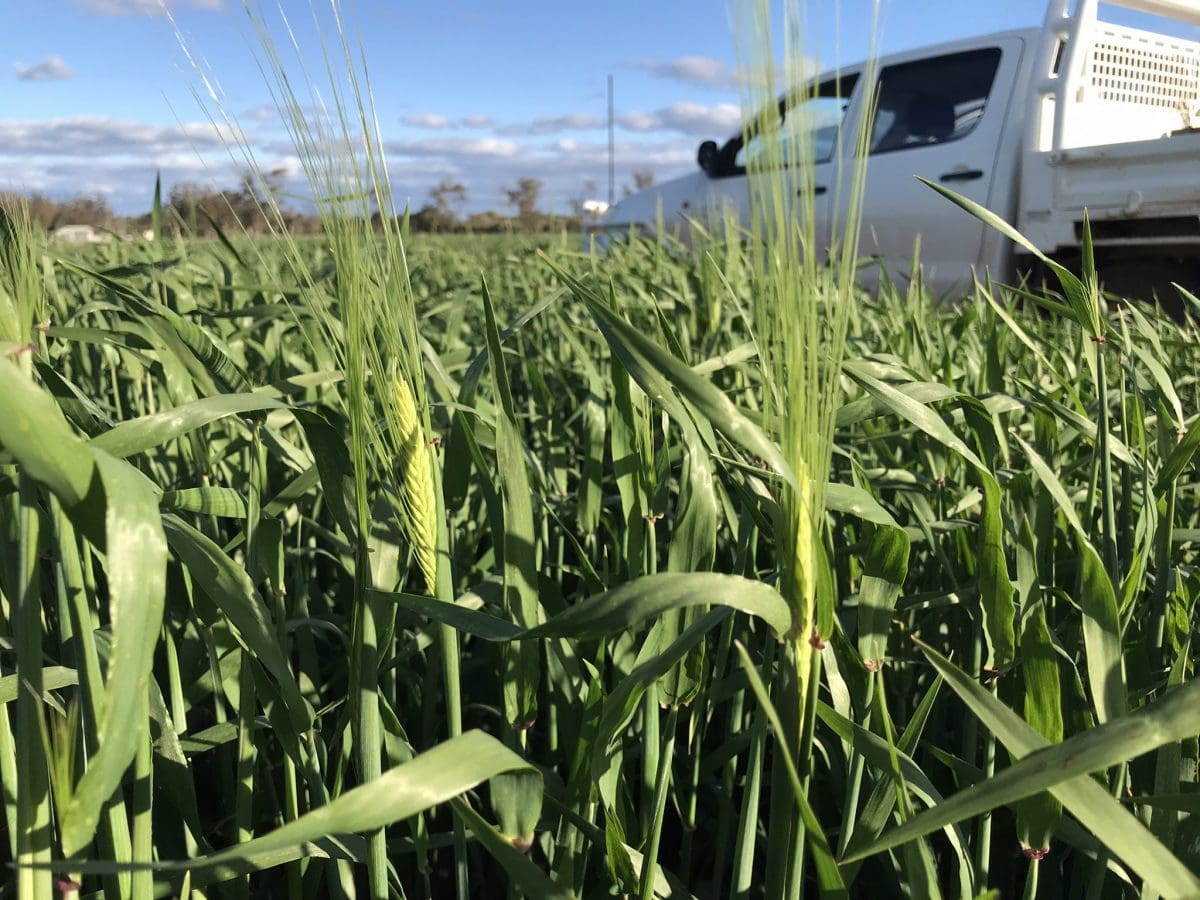
Some barley crops in Queensland like this one on the Darling Downs are coming into head. Photo: Dave Beare
FURTHER rain across the Australian grainbelt in all areas bar Central Queensland in the past week has bolstered yield prospects and raised the likelihood of a big crop with a lower-than-average protein profile.
This is good news for domestic feedgrain buyers, who are increasingly confident that their supply areas will be awash with lower-protein wheat and plenty of barley too when new crop hits the bins in October.
Logistics remains a major factor, as exporters look to big stocks of higher-protein wheat left in inland New South Wales – up to 3 million tonnes of it — while the Canadian and northern US crops remain in dire straits in ongoing hot and dry conditions.
Meanwhile, domestic consumers in Queensland and NSW are running behind on deliveries as showers, storms and boggy roads and paddocks remain a hindrance to accessing grain stored on farm.
| Nearby | New-crop | |
| Barley Downs | $290 down $5 | $270 down $5 Jan |
| Wheat Downs | $328 down $4 | $300 down $3 Jan |
| Sorghum Downs | $292 down $8 | $270 steady Mar |
| Barley Melbourne | $270 up $2 | $273 up $3 Jan |
| Wheat Melbourne | $335 steady | $325 down $10 |
Table 1: Indicative delivered prices in Australian dollars per tonne.
Northern buying slow
Trade sources report end users have dropped their bids to reflect the limited amount of grain they need to book to cover themselves ahead of new crop.
Barley remains the grain of choice for feedlots, piggeries and poultry, and most of the top-grade sorghum business being down is for September delivery to container packers.
Shipping stems indicate around 125,000t of bulk sorghum is to be exported out of CQ ports and Brisbane by September.
“Most domestic buyers are being a bit cheeky and sitting back, knowing there’ll be plenty of grain around,” one Queensland trade source said.
“Transport is going to be the issue they’ll have to watch.”
A number of domestic feed mills in the north are waiting on grain they had pencilled in for early June delivery, with successive weeks of wet weather the cause for delay.
To everyone’s surprise, the NSW wheat export task is continuing at maximum pace, and Queensland ports are also shipping their fair share of cargoes.
“Everything’s still relatively firm, and there’s still a massive export program going on in NSW,” Agracom trading manager Brett Donoghue said.
“There’s a continual addition of vessels on the stem.”
More wet weather has made it difficult or impossible for growers to spread urea on their wheat crops, and Mr Donoghue said this was affecting the expected profile of new crop.
“There’s a bias towards a lower-protein crop.”
With another bumper eastern Australian crop now heading towards what is forecast to be some weather in the next week, Mr Donoghue said domestic consumers had done “miniscule amounts” of new-crop purchasing when compared with their normal buying patterns.
“Production is not going to be a problem, but flour millers might be getting a bit nervous.”
Mr Donoghue said growers had not done much forward selling to date.
“I wouldn’t say a lot of tonnes have been offered up; it’s certainly not putting any pressure on price.”
He said while barley pricing was being driven by domestic demand, wheat was being affected by offshore factors, and the logistics of getting grain left in inland NSW to port.
“Trucks and train sets need to get under what’s still out there.
“Growers are well sold re grain in the system, and the big question is still what’s on farm.
“It points to a busy logistical task before harvest. “
The big news in the global market in recent weeks has been the lift of high-protein wheat against base grades as sparked by troubled conditions in Canada and the northern US.
“We’re seeing more demand for hi-pro in containers and bulk, and Australia is seeing a lot of demand from end users and flour millers buying from the States and Canada, and any APH-type wheat from Griffith north in the carry-out will get drawn to the ports because of that hole.”
Southern wheat in demand
Wilken Grain trader Andrew Kelso said southern markets are also seeing demand for high-protein wheat.
“Wheat’s still strong, and barley’s steady.
“There are plenty of people chasing wheat, mostly exporters, and there’s certainly some export interest in protein wheat,”
Flexi Grain pool manager Sam Roache said Australia’s barley exports were slowing considerably in the closing months of the shipping year, but wheat was continuing apace as stocks left in NSW move to export.
“In barley, the carry-out is quite tight as we go into new crop.”
He said another big NSW wheat crop means tight truck and train logistics seen in recent months were likely to continue into 2023.
While a new-crop inverse is evident on base grades of Australian wheat as it faces competition from the Black Sea, protein is holding strong because of the North American situation.
“The protein market isn’t inverted, and we’re so cheap versus the competition that that will give us a chance to get all the Prime Hard-type wheat out before new crop.”
On current seasonal conditions, it looks like the Murray and Mallee region of Victoria and South Australia could well produce significant tonnages of high-protein wheat this harvest.
With their sandier soils and drier growing season to date, their growers have been able to spread urea more successfully than growers on heavier country in northern NSW, traditionally a major PH-growing area.
Grain Central: Get our free daily cropping news straight to your inbox – Click here

HAVE YOUR SAY